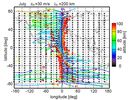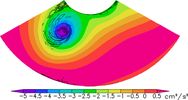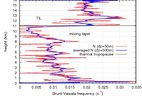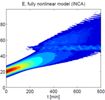Gravity-wave processes
The processes causing and controlling the spatio-temporal and spectral GW distribution fall under three classes: (1) GWs are emitted in source processes mainly located in the troposphere. (2) Hence they propagate through the atmosphere, interacting with the larger-scale flow, with other GWs, and with the tropopause. (3) GW instabilities and the interaction with turbulence lead to typically nonlinear GW dissipation. This classification is not strict. Turbulence due to GW dissipation, e.g., can lead to the emission of new GWs [VF01]. Presently important source-processes are either parameterized with insufficient constraints or no parameterization exists for them at all. Orographic GWs are implemented in all GCMs, but their representation is highly simplified. Orographic GWs, however, at least have well located sources, but this is not the case for convectively generated GWs. The variety of convection schemes in GCMs is large, and therefore also the convective GWs one could get from them. Even the most advanced convective GW source parameterizations, however, have insufficiently constrained parameters. Spontaneous GW radiation from synoptic-scale flow is a process which is presently not parameterized in atmosphere models. Another process of interest is the GW emission from hydrodynamic instabilities. There is an increasing appreciation that the present handling of WKB theory in the description of GW propagation and mean-flow impact needs improvements: The neglect of the impact of horizontal gradients and the time dependence of the large-scale flow is problematic, especially for the case of a comparatively rapidly varying background. Similar considerations hold for the common assumption that vertical GW profiles adjust instantaneously, from the ground to the model top, to changing propagation conditions, while in reality the effects propagate at the local group velocity. A prognostic GW model, treating these processes explicitly, would be an interesting alternative. Moreover, present WKB theory is not able to handle sharp gradients correctly, as e.g. encountered by GWs propagating through the tropopause. Reflection at or propagation through the tropopause, and the interaction with clouds in the upper troposphere/lower stratosphere may alter DFG form 54.012 – 2/13 page 9 of 25 the wave spectrum propagating into the middle atmosphere. Another important deficit finally remaining is caused by the new situation that models increasingly resolve some of the GWs. Therefore WKB theory should be re-considered so as to take the interaction of small-scale GWs with large-scale GWs into account. Nonlinear wave dissipation, finally, leads to momentum-flux gradients and also to turbulence which both influence the mean flow. Results from corresponding stability analyses and direct numerical simulations have so far not found their way into a parameterization of GW dissipation. Moreover, an analysis of the effects of the competition between amplitude growth, due to propagation into an increasingly rarified atmosphere, and nonlinear dissipation, seems to be still lacking. The considerations above motivate the following objectives:
►P1: Improvement and development of new GW source parameterizations (contributing projects: GWING, PACOG, SV, GW-TP, SI, 3DMSD):

- Enhancement of the constraint of orographic sources by the analysis of satellite data and model data.
- Improvement of the constraint of the parameters for convective sources by the same approach.
- Development of a working parameterization for GWs from spontaneous emission using theory, modelling, and laboratory experiments.
- Investigation of the GW emission from hydrodynamic instabilities.
►P2: Development and use of a prognostic WKB GW model (contributing projects: GWING, SV, GW-TP, SI, 3DMSD):

- Investigation of the impact of the tropopause and of upper-tropospheric clouds on GW propagation.
- Development of a WKB GW model with horizontal and vertical propagation, including the impact of three-dimensional gradients and time dependence of the resolved flow.
- Implementation of the WKB GW model into the global non-hydrostatic atmosphere model.
►P3: Improvement of the parameterization of GW dissipation (contributing project: 3DMSD):
- Mathematical analysis of the triggering of GW dissipation by modulational instability.
- Theoretical study of GW dissipation by small-scale instabilities.

